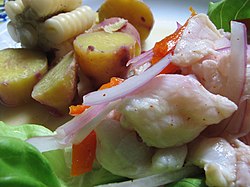| Gastronomic Fair in Trujillo | |
|---|---|
 Shambar is a typical dish of Trujillo city | |
| Genre | Gastronomy festival |
| Begins | November (last edition) |
| Ends | November |
| Frequency | annual |
| Location(s) | Trujillo city, Peru |
| Years active | 2011 - present |
| Inaugurated | 2011 |
| Most recent | 2012 |
| Attendance | 27.000 (estimated) [1] |
Gastronomic Fair of Trujillo called Sabe a Peru is a gastronomy festival held in the Peruvian city of Trujillo. This festival has been held on 17 and 18 November 2012. It took place in Mall Aventura Plaza Trujillo. [2] In 2012 the festival paid tribute to the "mochero chili" [3] for being an indigenous product, Moche culture legacy. Its historical roots are attractive to encourage experiential tourism in ancestral plots of Trujillo. [4]

